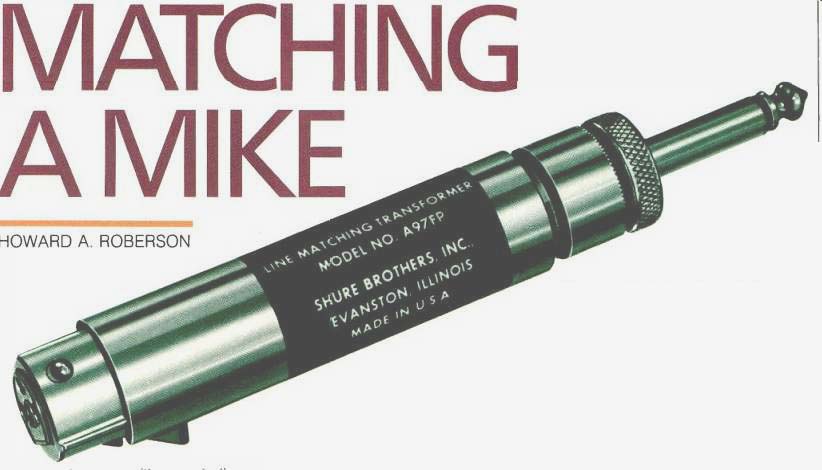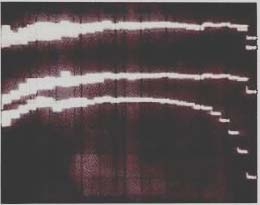
by HOWARD A. ROBERSON
In most cases with non-studio recorders, significant improvements in the quality of live recording can be gained by using professional micro phones. With a small number of exceptions, these microphones are low-impedance sources with the signal fed via a shielded cable with two inner conductors. This signal pair is actually floating electrically and is not connected to the microphone case, which is connected to the shield. Because of the low source impedance, the signal can be fed long distances with very little high-frequency roll-off. As most noise is picked up equally in the two signal conductors, it can be reduced greatly by the use of a transformer or a well-balanced electronic input at the end of the cable run.
Because high-fidelity and semi-pro recording equipment does not, in general, have the three-pin inputs and configuration for proper termination of such cable runs, it is common practice to use transformers that are designed to match the low-impedance source (microphone) with the recorder's input impedance. This sounds pretty simple and direct, and it is. But there's a catch: The input/terminating impedances vary among equipment types.
Most professional equipment will have an input impedance of 20 to 50 kilohms on each high-impedance in put. (For example, the Ramsa WR S208 mixer has 20 kilohms, and the TOA MX-106R mixer-amplifier has 50 kilohms.) Matching transformers such as the Shure A95 Series are designed to match a typical microphone source of 150 ohms to such input impedances. Nevertheless, many cassette and open-reel recorders have medium-impedance terminations, on the order of 3 to 10 kilohms. If a nonprofessional microphone that matches this impedance is used, there is no deleterious effect from the load. However, with a professional microphone and the typical matching transformer, the input impedance of the deck presents a load that is too low in value.
In recognition of this factor, Shure also offers the A97 Series transformers that are made for medium-impedance loads, and they should be more widely used than they are.

Fig. 1--Effects of input impedance mismatch on frequency response (see
text). From top to bottom:
Overlaid responses for low/high impedance and low/medium impedance transformers feeding line input; response for low/medium impedance transformer feeding typical medium-impedance microphone input; response for low/high impedance transformer feeding medium-impedance mike input. (Vertical scale: 5 dB/div.)
Figure 1 illustrates the problem and the solution. At the top are two overlaid traces of pink noise at low impedance fed into the line input of a high-quality deck. In one case, the noise went through a low-to-high impedance transformer; in the second case, a low-to-medium impedance transformer was used. The responses are flat, with just minor differences at 20 kHz. The response in the middle trace was se cured with connection made to the recorder's microphone input using the low-impedance/medium-impedance transformer. The bottom trace reveals what can happen with a low-impedance/high-impedance transformer connected to this medium-impedance input. The roll-off is obviously quite severe, and it is not a cable-run effect.
The general guidelines to ensure against such losses are:
(1) Check the specifications of your recorder in its owner's manual, or contact the manufacturer. Do not accept verbal statements from sales personnel; ask to see the number in published form. (2) If the input impedance is less than 20 kil-ohms, plan to use low-impedance/medium-impedance transformers such as the Shure A97 Series. Do not accept transformers that "will match any in put," or which have no technical data sheet (such as comes with the Shure unit). (3) In case of doubt or lack of information, assume that the input on the recorder is medium impedance, and use that transformer. (4) If you do have to guess, and then find that you cannot get a high enough recording level with the medium-impedance transformer, try the low-to-high impedance transformer. There will be a higher voltage output, and there might not be too much roll-off with your particular recorder.
The probability is that low-to-medium impedance transformers will give you better responses--and I expect that's one of the reasons why you bought professional microphones in the first place.
(Source: Audio magazine, Aug. 1986)
Also see: The Compleat Microphone Evaluation--An Update (Sept. 1978)
Nakamichi Model CM-700 Electret Condenser Microphone Systems (Sept. 1978)
= = = =